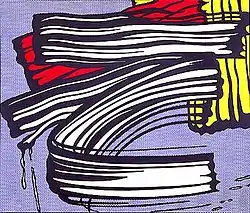Little Big Painting
Little Big Painting is a 1965 oil and Magna on canvas pop art painting by Roy Lichtenstein. It is part of the Brushstrokes series of artworks that include several paintings and sculptures. It is located at the Whitney Museum of American Art in New York City. As with all of his Brushstrokes works, it is in part a satirical response to the gestural painting of abstract expressionism.
| Little Big Painting | |
|---|---|
 | |
| Artist | Roy Lichtenstein |
| Year | 1965 |
| Medium | Oil and Magna on canvas |
| Movement | Pop art |
| Dimensions | 172.7 cm × 203.2 cm (68 in × 80 in) |
| Location | Whitney Museum of American Art, New York City |
Background

Measuring 172.7 cm × 203.2 cm (68.0 in × 80.0 in), Little Big Painting is part of the collection of the Whitney Museum of American Art.[1] It was acquired by purchase.[2] The source for the entire Brushstrokes series was Charlton Comics' Strange Suspense Stories 72 (October 1964) by Dick Giordano.[3][4] Like the rest of the 1960s elements of the series, this work is a response to the Abstract Expressionism of the prior two decades and was interpreted as a "wry commentary" in the Whitney Museum's accompanying statement plaque for its inaugural exhibition (America Is Hard to See) at its new location in 2015.[2]
Details
Little Big Painting is quite attentive to the "physical qualities of the brushstroke" relative to other Brushstrokes series works. It is an example of the use of overlapping forms rather than a single form or distinct adjacent forms, which seems to create a more dynamic feel to the shallow space.[5] However, since Lichtenstein does not uses shading or contrast, the monochromatic strokes with just bold black outlines are void of certain elements of depth.[6] However, the thick solid black lines surrounding the various uses of color resemble a comic strip style.[2] The carefully orchestrated paint drips mimick the spontaneous results of the gestures of preceding style.[2] The work contains no narrative, leaving just the comic book form of Benday dots presented according to a plotted outline.[7] Later Brushstrokes works such as Big Painting No. 6 and Yellow and Green Brushstrokes go one step further in terms of canvas size and dynamic activity that was presented earlier in Little Big Painting.[8]
Lichtenstein presents work that resembled the abstract expressionism that the contemporaneous viewing audience had become accustomed to seeing, however, his result is completely flat, without any trace of the brushstroke or the artist's hand. Meanwhile, the work references mechanical printing with the Ben-Day dots background, which enables Lichtenstein to parody his predecessors and make a "powerful abstract composition".[9] Although Abstract Expressionists in general considered their style as opposing popular culture, Lichtenstein's juxtaposition of the Brushstrokes against the mechanical process links the style to popular culture and results in a statement of the importance of mass media in the promotion of the style.[2]
See also
Notes
- "Roy Lichtenstein: Little Big Painting: 1965". Whitney Museum of American Art. Archived from the original on 2012-04-26. Retrieved 2012-05-25.
- America Is Hard to See Exhibition (Accompanying statement plaque). New York City: Whitney Museum of American Art. 2015.
- Foster, Hal (2010). Francis, Mark (ed.). Pop. Phaidon. p. 150. ISBN 978-0-7148-5663-6.
Begun in the autumn of 1965, Lichtenstein's series of Brushstroke paintings was initiated after he saw a cartoon in Charlton Comics' Strange Suspense Stories. 72 (October 1964). One scene shows an exhausted yet relieved artist who has just completed a painting. This depicts two massive brushstrokes that take up the entire surface area. The absurdity of using a small paintbrush to create an image of two monumental brushstrokes was explored in many different variations. Transforming an expressive act that was mythologized for its immediacy and primal origins into a cartoon-like, mechanically produced-lookiing image. Lichtenstein created a reflexive commentary on gestural painting.
- "Strange Suspense Stories #72". Lichtenstein Foundation. Retrieved 2012-05-25.
- Waldman. p. 161.
Other works in this series, such as Little Big Painting concentrate even more strongly on the physical quality of the brushstroke. The extreme magnification of the brushstroke, similar to the close-up imagery of the comic strip paintings, gives it added impact. The powerful thrust of the brushstroke is reinforced by its compact form. As a result, this painting more nearly approaches the kind of "glorious" brushstroke of the most significant gestural painters among the abstract expressionists. Little Big Painting is one of several paintings—of which other examples are the large canvas of the same year, Big Painting No. 6 (fig. 130), and the aforementioned Yellow and Green Brushstrokes— in which Lichtenstein uses overlapping forms rather than centering one form or placing two side by side.
Missing or empty|title=(help) - Waldman. p. 161.
This arrangement of dense, impacted forms creates the illusion of active shapes in a shallow space; but because they lack any sense of relief or depth and have been reduced to flat colors and a single bold outline, without any subtle contrasts between light and shade, they read as flat forms on a flat plane.
Missing or empty|title=(help) - Rondeau, James and Sheena Wagstaff (2012). Rigas, Maia M. (ed.). Roy Lichtenstein: A Retrospective. Art Institute of Chicago. p. 50. ISBN 978-0-300-17971-2.
- Waldman. p. 161.
In Big Painting No. 6 and Yellow and Green Brushstrokes, Lichtenstein dramatically enlarged the size of the canvas and increased the dynamic activity that was so much a part of Little Big Painting.
Missing or empty|title=(help) - "Roy Lichtenstein, Little Big Painting, 1965". Whitney Museum of American Art. Archived from the original on 2012-04-03. Retrieved 2012-05-24.
References
- Waldman, Diane (1993). Roy Lichtenstein. Solomon R. Guggenheim Museum. ISBN 0-89207-108-7.